Gold collapsed on dollar rebound, with eyes on inflation data,WHAT IS THE NEXT?
Recent problems in the US and Swiss banking systems have led markets to sharply cut interest rate expectations for the Federal Reserve. In just a few weeks, traders have changed from expecting four rate hike to wondering whether the Fed will continue its rate hike or even cut interest rates as soon as this summer (Figure 1).
SOFR futures curve on March 24th and March 8th
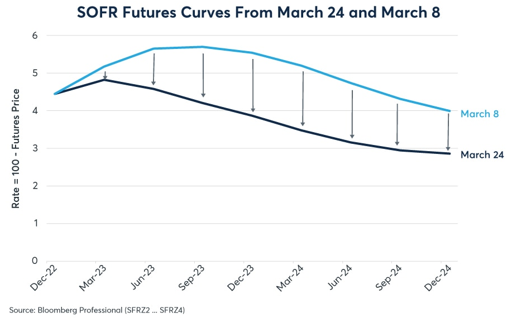
The sharp change in interest rate expectations is good for gold. Gold is a de facto currency, and almost every major central bank has a large reserve of gold. However, gold is a non-interest-bearing currency. Therefore, when rate hike expectations are formed, gold prices tend to weaken. In fact, since the end of 2021, because investors' expectations of short-term interest rates have risen rapidly, gold prices have been unable to rebound (Figure 2), even though inflation rates in the United States, Europe, Latin America, South Korea and Japan soared at that time.
The sluggish price of gold has puzzled many investors who regard gold as an inflation hedge. However, in this case, inflation and interest rate expectations are exerting forces in opposite directions, and with the Federal Reserve launching the largest rate hike since 1981, rate hike's downward pull on gold prices seems to temporarily exceed the upward push of inflation.
Federal Funds Futures 2-Year Forward and Gold
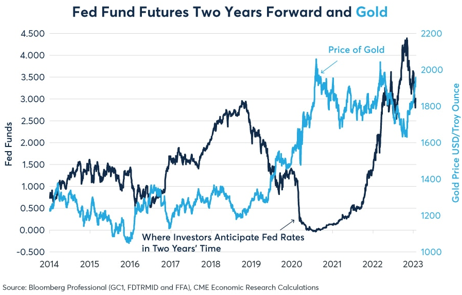
One might argue that the rise in gold prices from $1,200 to $2,000 an ounce between 2018 and 2020 is a foretaste of current global inflation. The incentive for this round of rebound is the expectation that the Federal Reserve will start to cut interest rates in 2019, but in fact, the Federal Reserve has implemented three interest rate cuts of 25 basis points. When the Federal Reserve cut interest rates by 150 basis points again at the beginning of the epidemic and expanded its monthly balance sheet by 1 trillion US dollars from March to May 2020, the gold price rise was further supported. However, when the price of gold peaked in July 2020, the US interest rate expectation just reached the lowest point.
Gold is negatively correlated with the daily change of interest rate expectation for a long time. When investors expect the Fed to tighten its policies more, the price of gold will fall, while when the expectation becomes that the Fed will tighten its policies less (or the Fed will cut interest rates more), the price of gold will rise. This correlation has been particularly evident in the past year (Figure 3).
Correlation with Federal Funds rate's 2-year long-term
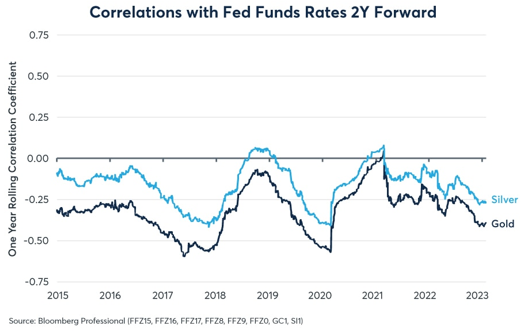
As far as the Fed and its expectations of monetary policy are concerned, the central bank is in a dilemma. Right now, the Fed needs to deal with two problems: inflation is too high at 6% (the Fed's target is 2%), and the banking system is under pressure. If we want to curb the high inflation rate, we must raise interest rates. However, continued rate hike may lead to increased uncertainty for regional banks.
Under the influence of two closely related phenomena, the profit margins of these depository institutions are in jeopardy. First, the rise in long-term bond yields has led to losses in some banks' long-term loan portfolios and positions in the US Treasury Bond (as in Silicon Valley banks). In addition, the upside-down yield curve also reduces the inherent profitability of banks. The rise in short-term interest rates means that they must pay more interest to savers in order to borrow money. On the contrary, because the long-term interest rate is lower than the short-term interest rate, they cannot make the same profits when using these deposits to lend. Finally, the tightening of monetary policy may also lead to an increase in loan default rate.
Given the plight of these lenders, the Fed may consider cutting interest rates. However, the high core inflation rate still facing the Fed has not been substantially alleviated, and the Fed interest rate is still 75 basis points lower than the core CPI (Figure 4). In Europe, the situation is even more grim, with the policy interest rates of the European Central Bank and the Bank of England more than 200 basis points lower than the core inflation rate. In addition, although there are some layoffs in the technology industry and some regional banks are in trouble recently, the US labor market is still tight (Figure 5).
Core CPI in Federal Funds rate and the United States
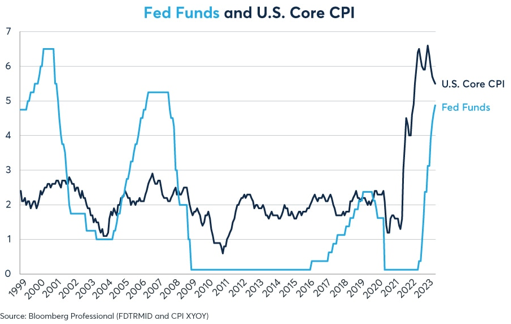
Vacant Jobs (JOLTS) and Labor Turnover Rate in the United States
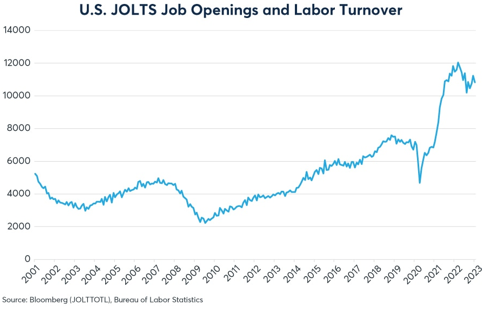
A reduction in labour market shortages, coupled with a recession in the US economy and/or a decline in core inflation, could mean more interest rate cuts than reflected in the current forward curve, and gold prices could continue to rebound. On the contrary, if economic growth remains resilient and/or inflation continues to be higher than the Fed's target, the Fed's rate hike may exceed the current prediction of the forward curve. If this happens, the price of gold may face downward pressure again.
Faced with this uncertainty, option traders priced the implied volatility of gold options at about 20% according to CME group CVOL Index Tool, which looks at the exercise price of a series of options. This level is close to the long-term average level of the market and far lower than the high level in 2020 and early 2022 (Figure 6).
Gold CVOL index
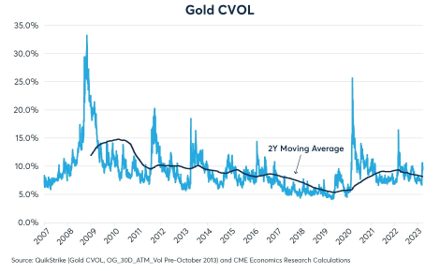
Even so, gold traders price the extreme upside risk of gold much higher than the extreme downside risk. The upward volatility of CVOL index (options with exercise price higher than the current spot price of gold) is about 22%, while the downward volatility of CVOL index is about 18% (options with exercise price lower than the current spot price of gold). This means that the price skewness of traders is about 4%, or the upward volatility is about 4% higher than the downward volatility (Figure 7).
Skewness of gold CVOL index and Federal Funds rate
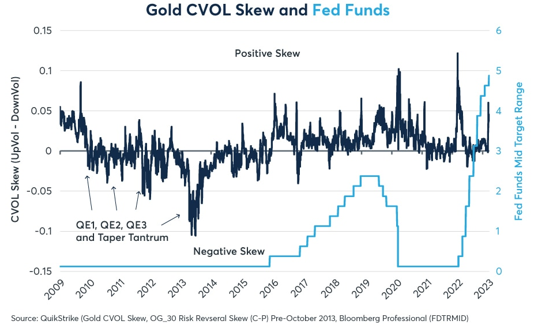
However,Such information should be interpreted with caution. In the past, when traders priced gold upside risks higher than downside risks, gold prices tended to perform poorly in the next few months (Figure 8).Conversely, when traders price downside risk higher than upside risk, gold tends to get higher than usualThe return. Therefore, traders' bullish on the upward risk of gold may turn into a bearish price trend. After all, with the Fed cutting interest rates by 200 basis points in forward pricing, this optimism about lower interest rates may already be reflected in gold prices to a large extent.
Gold CVOL skewness from 2009 to 2023 and gold futures return rate in the next three months
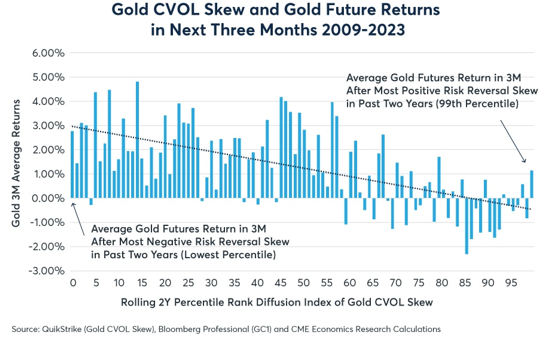
Content from: cme
$E-mini S&P 500 - main 2306(ESmain)$ $E-mini Dow Jones - main 2306(YMmain)$ $E-mini Nasdaq 100 - main 2306(NQmain)$ $Gold - main 2306(GCmain)$ $WTI Crude Oil - main 2306(CLmain)$
Disclaimer: Investing carries risk. This is not financial advice. The above content should not be regarded as an offer, recommendation, or solicitation on acquiring or disposing of any financial products, any associated discussions, comments, or posts by author or other users should not be considered as such either. It is solely for general information purpose only, which does not consider your own investment objectives, financial situations or needs. TTM assumes no responsibility or warranty for the accuracy and completeness of the information, investors should do their own research and may seek professional advice before investing.

Great ariticle, would you like to share it?
Great ariticle, would you like to share it?
H
Gold prices
👍🏼
Ok
repost